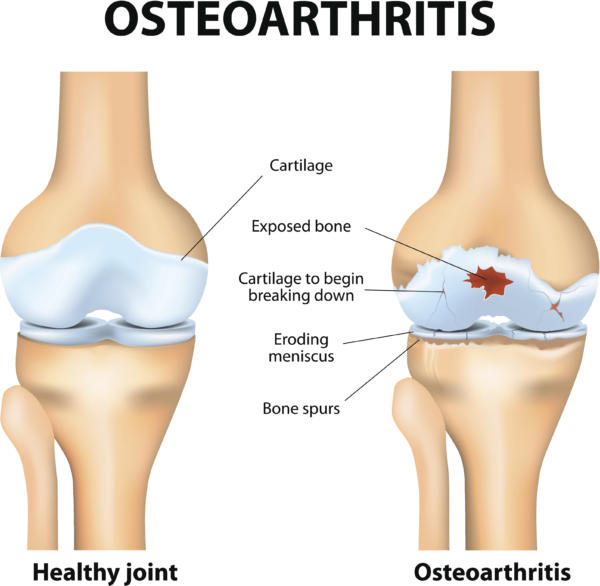
Do you suffer from joint pain? Perhaps you have pain in your knee, hip or hands? Joint pain is a typical symptom of osteoarthritis. Osteoarthritis is one of many different types of arthritis, but the one that is most common.
In this article, ZOOM Lead Pharmacist Din Redzepagic explains the causes of osteoarthritis, its symptoms, how it differs from rheumatoid arthritis, and details the over-the-counter and prescription osteoarthritis treatments available in New Zealand.
What is osteoarthritis and what causes it?
Osteoarthritis occurs when the cartilage which protects the end of the bones in our joints is gradually worn away and damaged or broken down.

The bone ends may also lose shape and thicken, creating bony spurs. The tissues that attach muscle to bone and hold the joint together can also be affected.
In more severe cases, osteoarthritis can lead to bone rubbing on bone in the joint.
Many factors may contribute to causing osteoarthritis.
Osteoarthritis may be caused by repeated use of the joint due to ageing. Whilst it can occur in younger people, the risk of osteoarthritis increases with age. Around 1 in 4 New Zealanders aged 55 and over have it.
Osteoarthritis can also be caused by a joint injury – such as a sporting injury – or by hard repetitive activity as in certain jobs such as labouring or professional dancing and sports.
Other risk factors for osteoarthritis include:
- Excess weight
- Gender – women are more at risk
- Badly aligned joints
- Some other illnesses – eg rheumatoid arthritis, some metabolic disorders such as type 2 diabetes
- Infections
- Surgery to repair injuries, especially knee surgery
- Genetic factors
The difference between osteoarthritis and rheumatoid arthritis
Rheumatoid arthritis is the second most common form of arthritis. It differs from osteoarthritis as it is an auto-immune disease. This means that the body’s own immune system attacks the joint lining causing inflammation and damage to the joint and bone.
Therefore, whilst some of the symptoms are similar and some of the drugs used to treat osteoarthritis may be prescribed for rheumatoid arthritis, in general the treatment of rheumatoid arthritis is different.
Osteoarthritis symptoms
The most common symptoms of osteoarthritis felt in and around one or more joints – usually the hands, hips, knees, spine, or ankles – are:
- Pain– usually worse with activity, but can become constant
- Stiffness in the morning, or after inactivity
- Swelling and tenderness
- Limited range of movement
- Grating feeling and crackling sounds when moving the joint
- Bone ‘spurs’ or lumps
- Muscle weakness
If you have these symptoms and they persist or worry you, please see your doctor. Your doctor will be able to diagnose whether your symptoms are caused by osteoarthritis, another type of arthritis, or a different condition.
Treatment and medicines for osteoarthritis
Medications for the treatment of osteoarthritis primarily help you to manage your pain. They might slow down its progress, however they don’t cure osteoarthritis or repair damage to the cartilage or bone.
The specific medication your doctor recommends will depend on how severe your pain is, and which joints are affected. Your doctor will ask you to try milder pain relievers first to reduce the chances of negative side effects.
Osteoarthritis medications currently available in New Zealand include:
Paracetamol
- Pain reliever
- Some people can control their pain with paracetamol alone
- Can help improve joint function
- Safe for most people when taken in the correct dosages
- Works best when taken regularly
- Taking more than the recommended dose can cause liver damage
- Alcohol should be limited to the level recommended by your doctor
- Available over-the-counter
- Funded
Topical Non-Steroidal Anti-Inflammatories (NSAIDs) – Voltaren Emulgel, Voltaren Osteo
- Gels or creams you apply to the skin around the affected joints
- Help reduce inflammation at the site
- Best when only a few joints are affected
- Can work as well as oral NSAIDs for some people
- May cause some side-effects, but fewer than NSAIDS taken orally
- Available over-the-counter
- Not funded
Capsaicin (Zostrix)
- A cream you rub onto the affected joints
- Works by interrupting pain signals to the brain
- May take 1 to 2 weeks to work
- You might feel a temporary burning sensation (as it’s the chemical that puts the heat in hot chili peppers!)
- Make sure you wash your hands after application
- Available over-the-counter
- Funded with a Special Authority for some patients (if your pain hasn’t improved with paracetamol and you can’t take oral NSAIDs)
Oral Non-Steroidal Anti-Inflammatories (NSAIDs) – ibuprofen, naproxen, diclofenac, celecoxib
- Tablets or capsules
- Reduce inflammation/swelling and associated pain
- More effective for pain relief than paracetamol
- Can have serious side-effects so best used at lower doses and for short periods
- Lower strengths available over-the-counter
- Funded with prescription
Local corticosteroids
- Injections into the affected joint that suppress inflammation
- Give only short-term pain relief (for many only 2 weeks)
- Suitable for infrequent severe flare-ups
- Injections must be at least 3 months apart to avoid damaging the joint
- Infection is a rare side-effect
- Not funded
If your osteoarthritis pain isn’t controlled well by these medications, your doctor might prescribe pain killers which include mild opioids such as codeine or tramadol.
Always consult your doctor or pharmacist
Whilst some arthritis medications are available over the counter, you should always consult your doctor or pharmacist before taking them. They will consider your individual situation and other medicines you are taking to ensure you are not at risk of serious side effects.
Exercise and other natural treatments for osteoarthritis
Whilst medicines can be helpful in managing pain – there are many other things you can do to help manage your osteoarthritis.
Exercise is probably the best. Appropriate exercise can reduce pain and inflammation and strengthen muscles around the joint. Exercises to Keep you Moving from Arthritis NZ can help guide you.
Other treatments include:
- Weight loss – can significantly improve your symptoms in weight-bearing joints and slow down further damage
- Physiotherapy
- Hot baths or showers and cold packs
- Joint protection aids – walking sticks, splints, braces
Arthritis NZ is an excellent source of further information. Or ask your doctor for a green prescription.
ZOOM Pharmacy is here to help
If you have any questions about your osteoarthritis medications, I or one of our friendly pharmacists can help. Call 0508 966 622 – 8.30am to 5.30pm.
You can also get your osteoarthritis medications online and have them delivered directly to your door.
Simply send ZOOM your prescription. You can do this through your patient portal, or tell your medical centre to send it, or take a photo and securely upload your prescription, or freepost / courier it yourself. A pharmacist will then get in touch and take it from there.
Get FREE* prescriptions! Plus if you are on 4 or more funded prescription medicines, you get FREE prescriptions, packing and delivery.
References (accessed May 2021)
- https://bpac.org.nz/2018/osteoarthritis.aspx
- https://www.mayoclinic.org/diseases-conditions/osteoarthritis/symptoms-causes/syc-20351925
- https://www.healthnavigator.org.nz/health-a-z/o/osteoarthritis/
- https://www.southerncross.co.nz/group/medical-library/osteoarthritis-symptoms-diagnosis-treatment
- https://www.nps.org.au/news/osteoarthritis-an-opportunity-to-promote-weight-loss-with-patients
- https://www.health.govt.nz/publication/annual-update-key-results-2019-20-new-zealand-health-survey

